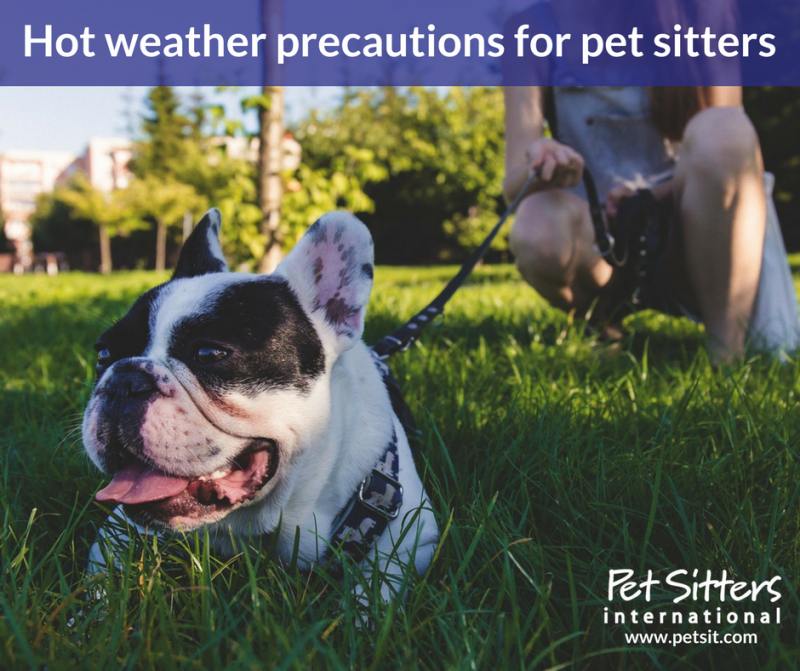Hot weather precautions for pet sitters

Hot weather and sunny skies signal the start of summer—a time for vacations and relaxation by the pool, or if you’re a professional pet sitter, perhaps a busier work schedule.
You may love your professional pet-sitting job, but it won’t be all fun in the sun if you don’t take some simple precautions to protect the pets in your care—and yourself—in hot weather.
Here are a few important hot weather precautions to keep in mind this summer:
Don’t feel the burn. Whether you are spending time with pets outside or driving from assignment to assignment, you should take some steps to protect your skin and the skin of the pets in your care. No one wants to feel the pain of a sunburn, and both humans and pets alike are susceptible to skin cancer.
Wear water-resistant sunscreen of SPF 15 or higher, and keep it handy in your car or pet-sitter bag so you can reapply it every two hours. You can also wear long-sleeved shirts and long pants, and add a hat with at least a 3-inch brim and sunglasses to protect your face and eyes. If you have staff sitters, educate them about the importance of wearing sunscreen and taking precautions to protect themselves from the sun. For more tips, visit www.skincancer.org.
For your canine clients, you can get sunscreen created specifically for dogs, which excludes ingredients that are toxic for them like zinc oxide. Regularly reapply sunscreen to the dog’s sensitive areas (e.g. nose, around the lips, tips of ears, belly and groin), and if your plans include taking Fido for a swim, remember to immediately reapply sunscreen afterward. You can also take other precautions when outdoors, such as outfitting the dog in a bodysuit or shirt, a hat with UV protection and doggy goggles. Check with the clients to see how they normally protect their pets when outside, and make recommendations if necessary. Articles on the PetMD and Vetstreet websites offer more tips regarding pets in the sun.
Avoid the hottest hours. For many pet sitters, summer is a busy time, with more pet owners seeking your services due to their planned vacations. Your schedule may be heavy, but if at all possible, try not to walk dogs during the hottest part of the day. If possible, complete most walks before 10 a.m. or after 4 p.m. On the hottest days, suggest to clients that dog walks be substituted with quick potty breaks and playtime indoors.
If you have to be outside during peak sun hours, take regular breaks to seek shade under trees or other structures, and keep water on hand for you and your doggy client. When temperatures rise, remember to wear “loosefitting, lightweight, light-colored clothing,” Mayo Clinic advises, and stay hydrated.
And for the pets in your care, don’t forget that hot pavement can injure pets’ paws. Here’s a quick tip: Place the back of your hand on the pavement, and if you can’t hold it for five seconds, it’s too hot for a dog walk.
Bonus tip: Even the indoors can be a threat to pets if temperatures are allowed to rise. We have heard stories from pet sitters who discovered that pet owners tried to cut energy costs by leaving the thermostat up or turning the A/C off altogether while they were gone during the summer. During meet and greets with clients, make sure to discuss thermostat settings, and get clients’ permission to adjust the temperature if necessary for pets’ comfort and safety. Remember: If it’s too hot for you, it’s too hot for the pets!
Know the signs of heat exhaustion. Even if you plan to take precautions this summer, you should still be aware of the signs of heat exhaustion, as well as how to respond. According to Mayo Clinic, possible heat exhaustion symptoms may include: “cool, moist skin with goose bumps when in the heat; heavy sweating; faintness; dizziness; fatigue; weak, rapid pulse; low blood pressure upon standing; muscle cramps; nausea; headache.” If you think you may be suffering from heat exhaustion, find a cool place, rest and replenish fluids with water or sports drinks. Call a doctor if symptoms worsen or don’t improve within an hour, Mayo Clinic advises, and seek medical attention if your body temperature reaches 104 F (40 C). Learn more about heat exhaustion on the Mayo Clinic website.
Pets can be dangerously affected by the heat as well. Signs of heat stress in pets could include trouble breathing, excessive panting, increased heart rate, weakness or collapsing. Contact the pet’s veterinarian immediately if you expect the pet is suffering from heat exhaustion. Always have the veterinarian’s information and a cell-phone handy should you need to contact the vet in the case of an emergency.
Never leave pets in a vehicle. We’ve all read the stories—tragic accounts of a pet owner or sitter who left a pet in a vehicle and came back to find the pet dead. According to the AVMA, hundreds of pets die from heat exhaustion each year because they are left in parked vehicles. Even with the windows cracked or the air conditioner running, temperatures can rise quickly in a vehicle and put pets at risk of serious illness, or worse, death.
As a professional pet sitter, you have the opportunity to educate your clients and your community about this important topic. Don’t forget to share the free social media images PSI makes available throughout the summer months. By warning local pet owners about the dangers of leaving their pets in vehicles (even for a short time), you could be saving a pet’s life.
For more summer pet-safety tips, read this post from The PSI Blog, 10 summer pet-safety tips for pet sitters and pet owners.
Pet sitters, what precautions do you take to protect yourself and the pets in your care when temperatures rise? Share in the comments section below.







Comments
No comments.